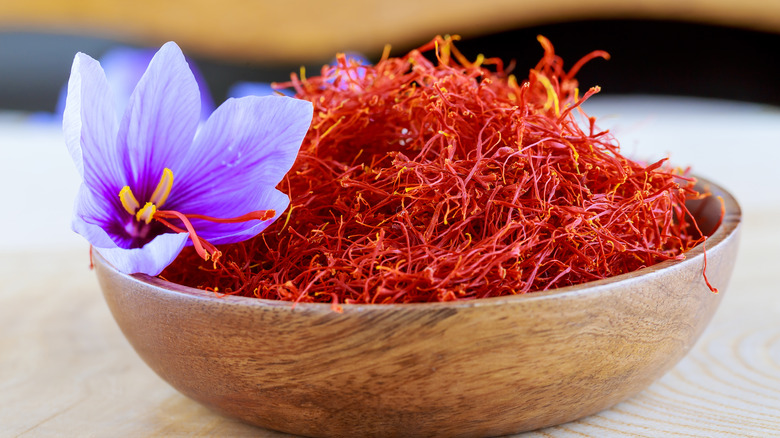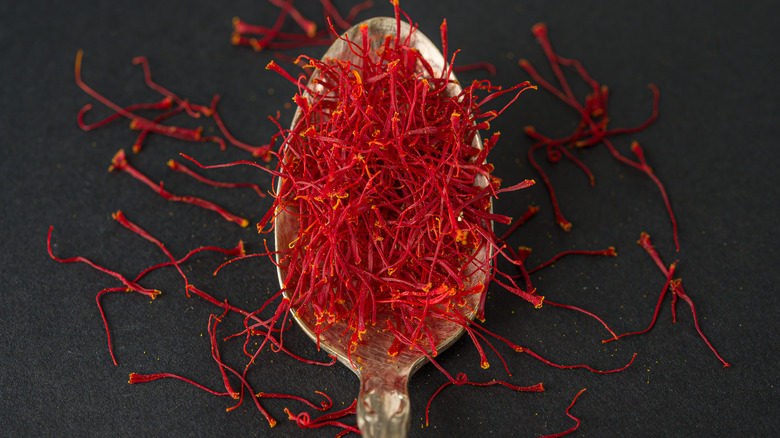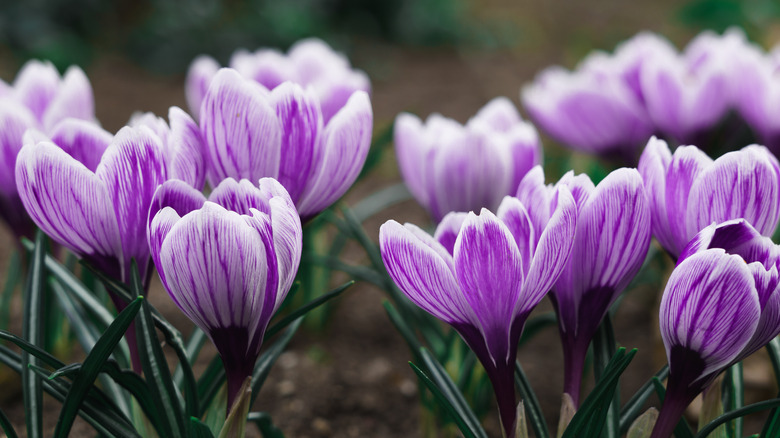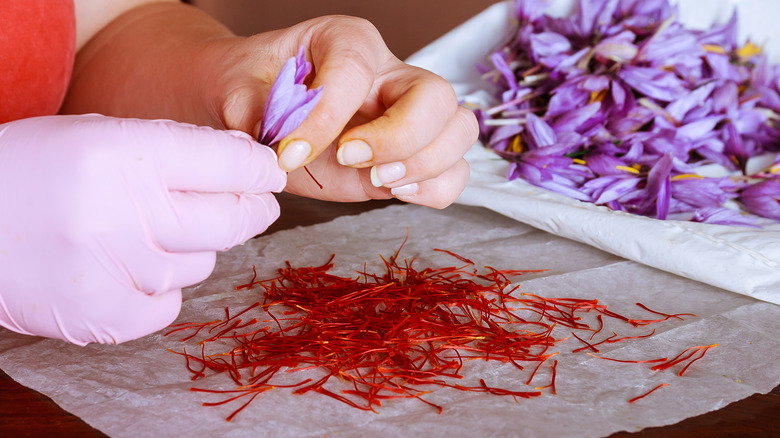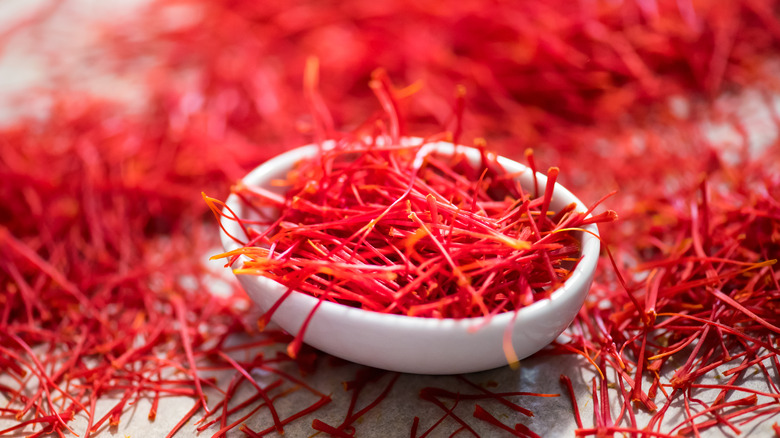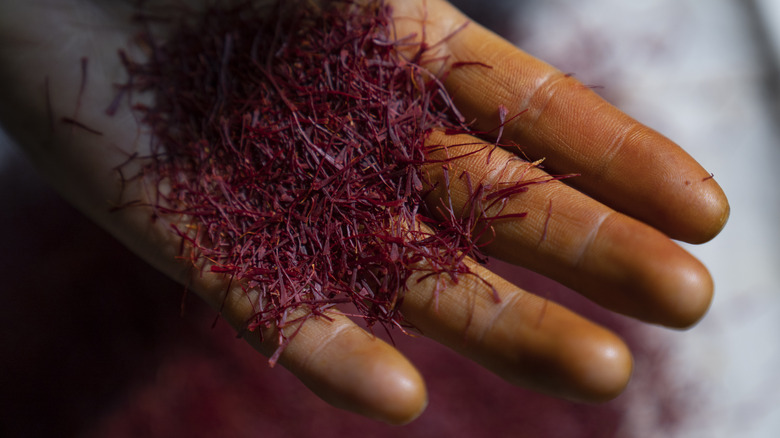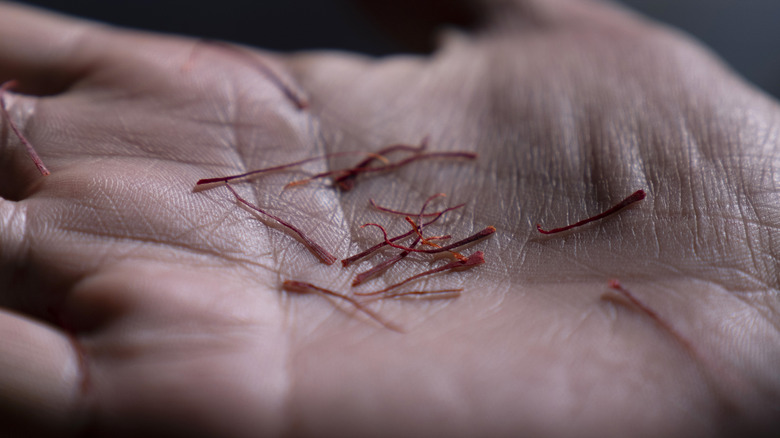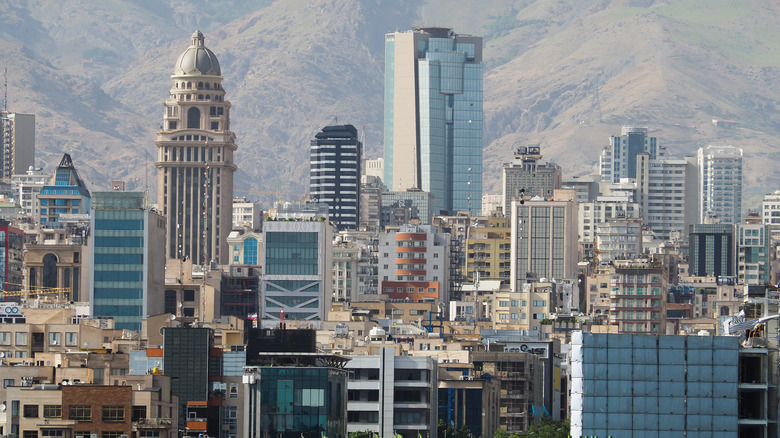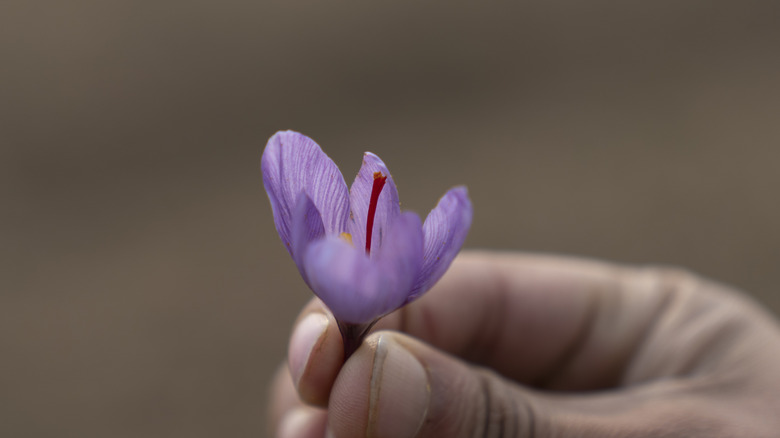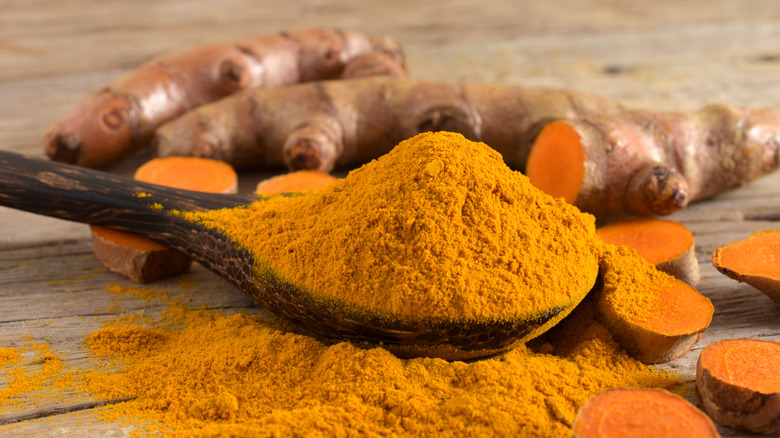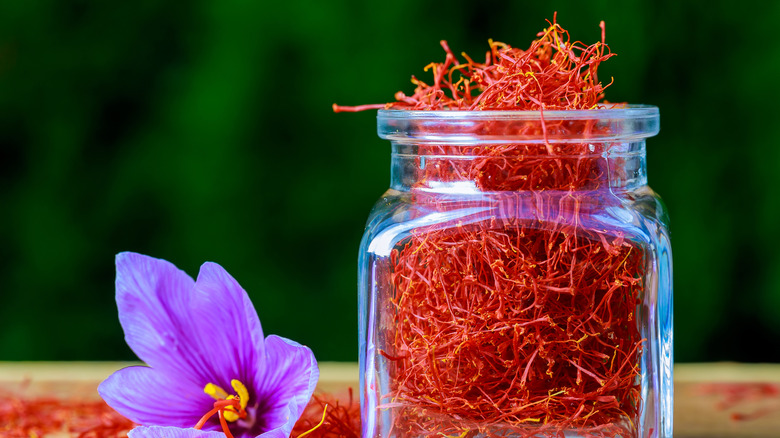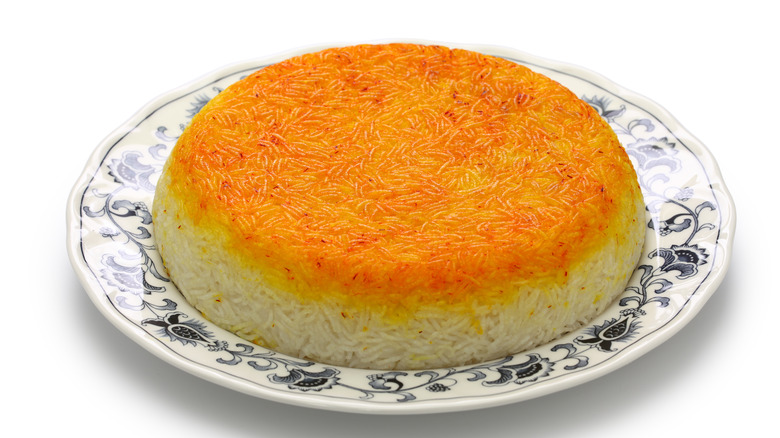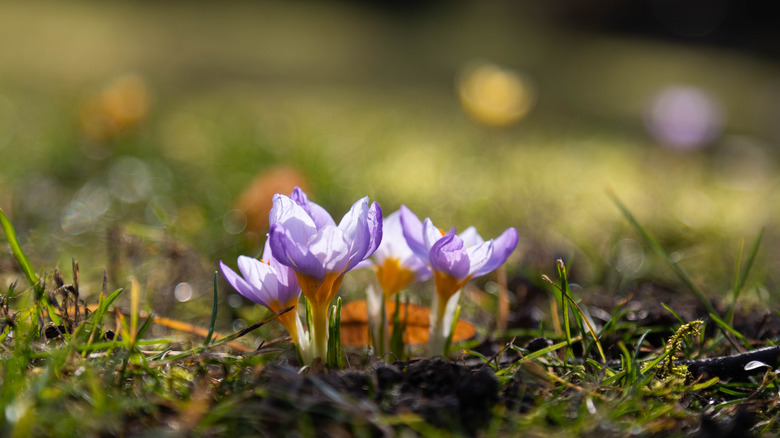The Untold Truth Of Saffron
Even those with the most well-stocked spice cabinets in the world will know that saffron is something special. This luxurious spice comes from a vibrant purple flower known as the crocus sativus (per Bon Appétit), but it's most well known for the bright yellow color it imparts on everything it touches. It's not exactly a cheap ingredient to keep in your home, so if you have some, you probably use it sparingly. However, even if you love saffron and use it on the regular, there's probably a lot you don't know about the spice. But since it has a history that spans all the way back to ancient times, there's a lot to learn about this spice that has changed the course of human history.
How much do you already know about saffron? Let's take a look at some of the most interesting facts about one of the world's most legendary ingredients. The next time you reach into your spice cabinet to pull out some saffron, you'll have a slightly better idea of how it ended up on your plate and why you should keep eating it.
It's the most expensive spice in the world
While certain spices in your kitchen may be pricey, they probably don't generally comprise a majority of your grocery bill. However, if you've ever seen saffron in a recipe you wanted to try and went to pick some up at your local grocer, then you may have already realized that this stuff isn't cheap. Well, that's an understatement. It happens to be the most expensive spice in the world, and according to The Spruce Eats, saffron "is worth its weight in gold."
While the price will depend on market conditions as well as where you buy your saffron from, you can expect to pay a pretty penny. Last year, Business Insider reported saffron can cost up to $10,000 per kilo. However, considering you don't have to use that much of it to add color and flavor to a dish, you can buy small amounts of it at a time. Many large grocery stores will stock it, but if you can't find it there, you're probably best off finding it at a Middle Eastern grocer if you're lucky enough to have one in your area. If not, you can always try online as well.
It can potentially improve your mood
We all have those days — or weeks — when we're just not feeling our best. Whether that's because the weather has been gloomy or you just have too much on your mind, when you start feeling less than happy, you may want to start looking for some solutions. If you're looking to make some changes in your diet, you may be interested to know that some studies show that saffron could potentially have the ability to improve your mood, according to Healthline. They note that saffron is referred to as the "sunshine spice" not just because of its vibrant yellow color, but also because it could boost your mood.
Healthline also reports that five different studies have indicated that saffron was more effective than a placebo in treating mild to moderate depression, and other studies have shown that it could work as well as some antidepressants. That doesn't necessarily mean you should ditch your antidepressants (absolutely consult a doctor if you're considering doing that), but if you're looking for a slight mood boost, some saffron couldn't hurt. At the very least, cooking a delicious meal with a beautiful and bright ingredient might put a smile on your face.
Harvesting saffron is a tricky process
You may assume that the high price of saffron is due to the fact that the plant it comes from is difficult to grow, but that's not true. The plant itself isn't a particularly finicky flower, but the harvesting process can be incredibly time-intensive. First of all, crocus sativus has three sets of chromosomes, which means it's sterile. Therefore, people have to help it reproduce by hand, according to Everyday Health.
Of course, this would take a long time under any circumstances. But then, there's also the fact that every blossom from this plant only yields three stigmas, or super-delicate saffron threads. Therefore, it takes a massive number of flowers to produce even the smallest amount of saffron. Everyday Health reported that 75,000 flowers result in a single pound of saffron.
So, while the price of saffron might seem unreasonable, that price is just reflective of how much work and care goes into producing the spice. The next time you add some to your dish, you may want to take a moment to stop and appreciate all the people who helped make just this one ingredient of your meal a reality.
You should opt for whole threads over powder if you have the option
When you're shopping for saffron, you may not know exactly what you're looking for. And if you visit a store that has a few different options, it can be even more confusing. However, we may have the answers you're looking for. If you're shopping for saffron and you notice that both a powder and threads (also known as stigmas) are available, you're going to want to go with the threads every time, per The Spruce Eats. Why? First of all, they're going to keep their flavor for longer. Generally, you only use a small amount of saffron at a time, so you want to make sure your stock stays as fresh as possible for as long as possible. Powdered saffron will lose its flavor more quickly, and it's not as strong either.
But it's not all about the freshness factor — it's also a better way to ensure that you've actually purchased real saffron. When you buy saffron in a powdered form, you don't really know if it's been adulterated with other spices that can throw off the flavor or color. And the last thing you want to do is spend money on an expensive ingredient that doesn't taste its best.
Saffron could be an aphrodisiac
There are so many different foods that are touted as aphrodisiacs, but you may not have known that saffron is one of them. According to Healthline, saffron could potentially be an aphrodisiac, or a libido-boosting food, based on the findings of a few different studies. In one study, men suffering from erectile dysfunction and who were also taking antidepressants were given 30 milligrams of saffron for four weeks, and it worked better than the placebo.
In another study, women who complained of low libido due to antidepressant use also found that taking 30 milligrams over the course of four weeks improved their symptoms. And since this is a common problem in those taking antidepressants, it's good to know that there's a natural compound that may be able to help.
Of course, there's more research to be done to determine if saffron truly can function as an aphrodisiac, but these early studies show some interesting findings.
You don't need to use much of it
When you first see the price of saffron, you may panic. If you're used to cooking with other spices, it may seem like you're going to have to take out a second mortgage just to be able to finish tonight's paella. However, you should be pleased to know that typically, you don't need to use much saffron at all to add flavor and color to your dishes. According to Serious Eats, most recipes only need "a pinch" of the spice. Alternatively, you may see directions that encourage you to add several threads so there's some room for interpretation. And while some Moroccan dishes may call for more saffron than more lightly spiced dishes, you can always save those for special occasions.
If you're working with powdered saffron, though, it can be difficult to determine how much you should use if the recipe you're consulting calls for a pinch. Per Gourmet Sleuth, 1/8 to 1/4 teaspoon of ground saffron is roughly equivalent to a teaspoon of the threads.
Iran produces the vast majority of the world's saffron
One of the most famous dishes in Iranian is tahdig, a crispy, fragrant rice that is often prepared with saffron. It should come as no surprise, then, that the majority of the world's saffron is produced in Iran. According to the UN Food and Agriculture Organization (via National Geographic), a whopping 85% of the world's saffron comes from Iran. That's a huge amount of saffron coming from one country — especially one that's not that large, relatively speaking. However, according to some estimates, even more than 85% of saffron originates in Iran. According to Eater, the country produces over 90% of the world's saffron.
Why is so much saffron grown in Iran specifically? It largely has to do with the climate. The dry soil and sunny weather make for the perfect growing conditions for the saffron plant. But cultural knowledge is also a factor too. Proper planting and harvesting techniques have been passed down through the generations to the farmers that are growing this plant today.
If your saffron isn't coming from Iran, chances are it's coming from one of the country's neighbors. It tends to grow best in Mediterranean or similar climates. It's no wonder that this area produces some of the most delicious saffron-spiced dishes in the world.
The pandemic and U.S. sanctions have exacted a toll on the saffron industry
When people put food on their plates, most aren't thinking about the journey those ingredients took to get there. But the story of saffron is an excellent example of how food systems are more complicated and interconnected than they may seem on the surface. Iran has suffered under the weight of economic sanctions for decades, per Bon Appétit.
However, those economic sanctions once excluded items of significant cultural value. Saffron fell under that category. In 2018, though, the U.S. enacted even stricter sanctions on the country, and cultural items were therefore no longer excluded from the policy. Now, many Iranian saffron producers must sell their crops to middlemen, who then sell the saffron as Moroccan or Spanish in origin (despite the fact that only one percent of the world's saffron actually comes from Spain). Not only does this cause harm to Iranian farmers, but it also erases the contributions of Iranian saffron producers to consumers worldwide.
But it's not just U.S. sanctions that have spelled disaster for saffron farmers in Iran. The COVID-19 pandemic has also exacted its toll on the saffron industry as demand suddenly plummeted in 2020, according to Middle East Eye.
You can use substitutions in recipes ... but they're not as good as the real thing
Isn't it so frustrating when you start cooking a recipe only to discover that you actually don't have one of the ingredients you need? And when that ingredient is saffron, it's not as simple as knocking on your neighbor's door and asking for a cup of sugar. Therefore, you may be interested in learning about what you can substitute for saffron in a recipe if you don't happen to have any on hand. Turmeric can be used as a substitution in some recipes. It'll provide that golden yellow color that you get from saffron, but the flavor is quite different. Paprika can also be used similarly, but it too fails to provide the depth of flavor you want from saffron, which is difficult to describe but is certainly more floral than these other spices.
Our suggestion? Combine turmeric and paprika together (if they go with the rest of the recipe) if you don't have any saffron in your spice cabinet. But if you get the opportunity, make sure you grab some soon — it makes a huge difference in many recipes.
There are a few qualities to look out for when buying saffron
If you're not used to buying saffron, you may not really know what you're looking for when you visit the store. It's not like garlic granules or onion powder, where most brands and varieties will pretty much do the trick in most situations. Rather, you'll really want to pay attention to what you're getting when you buy saffron because you don't want to waste your money on a subpar spice. Therefore, there are a few qualities you should look out for when you check out the spice aisle, per The Spruce Eats.
First of all, you'll want to make sure your saffron is a deep red color. Yes, it'll turn the food you're cooking with yellow, but the threads themselves should be red — any yellow styles you see are only adding unnecessary weight. The threads should also look uniform in appearance, and they'll be wide and flat with tapered ends. Additionally, they should be dry to the touch. If they're wet and mushy, chances are they've gone bad. And don't forget to smell your saffron as well. It should have a nice, slightly sweet floral scent. Don't buy it if it smells musty in any way.
Hopefully, these tips and tricks will lead you to the very best saffron available.
It appears in a wide range of dishes from different cultures
While this spice may come from Iran, that doesn't mean that Iranian dishes are the only places you'll see saffron. Of course, Iranian tahdig sometimes contains saffron (but not always). But you'll also see saffron in a variety of other dishes, like tagine, sort of like a stew, which comes from Morocco. (As we mentioned earlier, Moroccan recipes often call for more saffron than recipes from other parts of the world.) Azerbaijani khan plov, which is like a chicken pilaf in a crust of lavash (a type of flatbread), also contains saffron. This special occasion recipe only calls for just a touch of the spice, but it lends an incredible amount of flavor to the dish.
One recipe that often features saffron is Spanish paella. This impressive dish hails from Valencia and sometimes contains seafood, although it can highlight other ingredients, like rabbit and snails, instead. In this dish, saffron is used to provide a lovely yellow color to the cooked rice, and the floral flavor complements the seafood well. And if you're into French cuisine, then you probably already know that many bouillabaisse recipes call for saffron as well.
Moral of the story: Saffron really has made its way around the world and has influenced countless cultures and cuisines in the process. What dish are you going to add saffron to next?
Climate change could be putting the crop at risk
Even though Iran is the top producer of saffron, it is grown in other parts of the world as well. One of those places is Kashmir, the northernmost part of the Indian subcontinent. The weather here has traditionally been ideal for growing saffron, but as the climate changes, experts are worried that it won't be long before that's no longer the case. According to Eater, saffron farmers are growing significantly less than what they were just years ago.
"When I was a young girl, there would be no place to sit after harvest," one saffron farmer named Mir told the outlet. "We would take months to finish processing the crop: my parents, my whole family, my brothers and sisters. Now within a month, we are done."
As climate change takes its toll on Kashmir and other regions in the world, the food that we've grown accustomed to, such as saffron, may not thrive like it once did. Farmers — and society at large — will have to face the costs.
